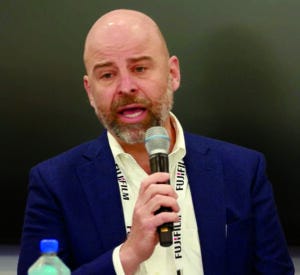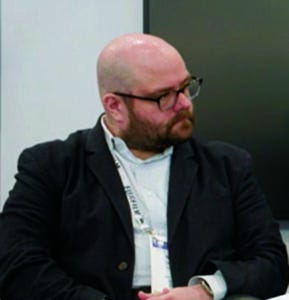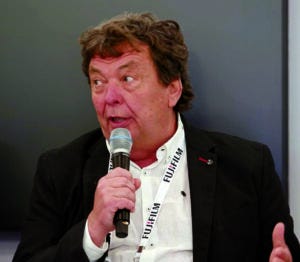- Sponsored Content
- Emerging Therapeutics
The Next Generation of Emerging Therapies and TechnologiesThe Next Generation of Emerging Therapies and Technologies
August 21, 2023
Sponsored by RoosterBio

(left to right) Nicholas Geisse (CEO, Curi Bio), Christian Cobaugh (CEO, Vernal Biosciences), moderator Reinhard Vogt (venture partner, Dynamk Capital), Ella Korets-Smith (chief strategy officer, Virica Biotech), and Tim Kelly (CEO, RoosterBio).
Moderator Reinhard Vogt opened the Tuesday afternoon roundtable by introducing the panelists. Vogt has been in the biopharmaceutical industry for 35 years, based for much of that time with Sartorius, where he played a key role in building that company’s bioprocess business. He now is a venture partner with Dynamk Capital, a VC company that provides financing and supports the commercialization of its portfolio companies by providing fundamental technologies and services.
The panelists’ edited remarks follow the speaker introductions below.

Tim Kelly
Tim Kelly is CEO of RoosterBio. The company provides the cellular starting materials, media systems, and bioprocess to enable scalable manufacturing of therapies based on cells and exosomes.

Ella Korets-Smith
Ella Korets-Smith is cofounder and chief strategy officer of Virica Biotech, a viral-vector enhancer company. It pioneered a product category of viral sensitizers (VSEs) designed to remove barriers to manufacturing effective viral medicines at scale. The VSE technology increases upstream yields of viruses such as adenoassociated virus (AAV) and lentivirus (LV) for delivery of gene therapies, vaccines, and other viral-vector products. Virica works with manufacturers of gene therapies and vaccines as well as contract development and manufacturing organizations (CDMOs) and reagent producers.

Christian Cobaugh
Christian Cobaugh is the founding CEO of Vernal Biosciences, an mRNA and lipid nanoparticle (LNP) formulation company. It manufactures mRNA for research and clinical applications and serves as an end-to-end service provider for research and clinical manufacturing of high purity mRNA.

Nicholas Geisse
Nicholas Geisse is the CEO of Curi Bio, based in Seattle, WA. The company uses stem cells to develop functional models of human muscle. The models are used in preclinical assays for cell and gene therapy providers and as potency assays for manufacture of new gene therapies.
Cancer Vaccines on the Horizon
Vogt:When we’re talking about emerging therapies, what progress do you see toward effective cancer vaccines?
Cobaugh: We’re seeing growth in all previous and emerging use cases for mRNA. Cancer vaccines have been in development for years — it’s been a bit of a graveyard, clinically and commercially. The key seems to lie in personalizing and basically turning cancer into an invading pathogen as

Reinhard Vogt
far as the immune system is concerned. We see many applications and much interest in gene editing. The new play on that isn’t just gene editing, in which the genome is being cut and perhaps [augmented] (usually it just is being repaired). Now attention is being directed toward gene regulation. We are essentially creating synthetic transcription factors to turn on and off pathways that are associated with diseases.
Kelly: From our perspective, one of the most exciting areas is the use of exosomes or extracellular vesicles as therapeutics. That’s a primary focus for RoosterBio: leveraging mesenchymal stem cell (MSC)–derived exosomes. A great deal of clinical validation is still needed. But given that so much clinical data are available on safety and tolerability and the unique therapeutic benefits of MSC-derived exosomes, we see many opportunities. A number of platforms have been developed. Key challenges lie with issues of scalable manufacturing and characterization. In addition to all of the RNA-based therapies, we think therapeutic exosomes will create a significant impact over the coming 20 years.
Korets-Smith: We are working with companies that have different viral vectors in development. What we’re seeing is that AAV remains the king of the gene therapy space. But people are getting much more precise about the kinds of capsids and genomes that they are manufacturing. I see quite a lot of interest in developing capsids that are targeted to specific tissues, for example. That’s certainly one big area of development.
A more provocative area might be in vivo LVs. In the future, maybe viruses other than AAV will go forward into gene-therapy products because I see a lot opportunity there.
Geisse: At Curi, we are involved early in the discovery process. Our specialty is taking stem cells from a patient or from a healthy individual, engineering in the disease (if needed), and using that to test new therapies. Some of the projects we deal with are human diseases that just can’t be modeled with animals, so we develop functional assays. We have customers who have muscle trophic capsids, for example, that they are trying to test before even beginning early pilot manufacturing experiments. We can test those in our system to see whether they truly are muscle trophic. Will the promoter be activated in the specific fiber of a specific muscle type? We try to improve the chances before going into manufacturing.
Vogt: What do you see as the major technology and regulatory challenges with emerging therapies?
Cobaugh: As a CDMO, we have two “customers”: the clients that pay us and the agencies that regulate our activity. To use personalized cancer vaccines, as an example, you hear about the needle-to-needle time — 30 days, 40 days, 60 days. Clearly, we’re not going to have a full release package as part of those approved products. So what does the regulatory pathway look like?
On the technical side in the nucleic-acid medicine space, delivery is the number one challenge. It rules everything. We can do amazing things with mRNA; it’s just a matter of getting it where it needs to go. We are seeing progress with in vivo cell therapy that enables delivery by injections. That represents the possibility of focusing past the liver, spleen, or lung and targeting areas in the heart and the brain. But we and, ultimately, our customers will need to develop new delivery technologies.
Kelly: For any stem-cell based therapy, scalable manufacturing is a key challenge that we are all working to solve. Focusing on MSCs in our case, we seek to implement a technology platform that enables a truly scalable manufacturing process. Instead of doing media exchanges, we can grow cells in bioreactors and reach clinically relevant doses at a cost of goods that makes better sense than the current use of flasks that create only small numbers of clinical doses.
Developing that type of scalable bioprocess is a key challenge. Then we have our work with exosomes in which patients are not dosed with a primary cell. That technology is more similar to working with therapeutic proteins or viral vectors than live cells.
Significant challenges remain. The purification process must provide desired purity, potency, and quality. Exosomes are heterogeneous products, so they contain different particles of different sizes and compositions. Conventional 0.2-µm filtration will present a big challenge with an exosome in a 50–200 nm range. Conventional systems yield poor recovery. So we are trying to figure out how to solve those problems.
Another big challenge is how to characterize these products because they are, again, so heterogeneous. We can’t just run conventional protein and vector-style analytical methods to get a good picture of a product.
So these are a few of the challenges that we are addressing, often in collaboration with other solution providers and technology companies. Our goal is to deliver a truly well-characterized exosome therapeutic. We certainly are making very strong progress.
Korets-Smith: The vector space is a bit more defined than the exosomes space, but it is still a little bit of the Wild West and still far from standardized processes, as exist for antibodies. The major issue in the viral-vector space is that production is not yet efficient. Viral vectors are produced in living cells, but living cells hate viruses. Virica is working to reduce production inefficiencies with our enhancers. We are implementing our small molecules in a manufacturing setting and reducing antiviral defenses in host cells. That allows us to get better upstream yields, which is needed to get to the scale that we’re all going to need for some of the larger gene-therapy applications.
Vogt:Another challenge with new therapies is to reduce their cost. A treatment cost of US$250,000 a year or more is not sustainable, not for the market, and not for the producers who treat millions of patients.
Geisse: I gave a talk at a bioethics course in Seattle in which I spoke about a single patient, a 7-year-old child here in Boston with a mutation that causes a form of Duchenne muscular dystrophy (DMD). We don’t know of any other patient who has it. A team at Yale University is working on a therapy. How much is it going to cost to treat this one kid with this one therapy? Participants in the course, mostly philosophers, asked about equity. Who in the world gets access to these therapies at the currently high costs? A kid in Boston in the western first world? My family is from Chile in South America. Would someone in my home country get that kind of access to healthcare? Cost is the big driver for these therapies.
Cobaugh: Traditionally, in the CDMO world, we’re working in cleanrooms that cost tens of thousands of dollars a day just to operate. We’ve talked about personalized medicines. We’ve talked about the unreasonable costs of manufacturing therapies for rare diseases. How do we invent new manufacturing tools? How do we create cleanrooms in a box that sits on a benchtop? And how could we operate continuous processing in an ISO 5 space? It’s about miniaturizations. It’s about engineering. And we really can’t do that work fast enough.
On the raw-material side, we just need more competition. That’s happening in the RNA space. It’s been awesome to see the progress of the past two or three years that lets us access full good manufacturing practice (GMP) traceability for raw materials. But costs are driven up mainly by processing time, the need for processing speed, and the need to maintain sterility and safety.
Kelly: I agree with the earlier comments. My previous company was an AAV gene-therapy company with a philanthropic arm that produced therapies for ultra-rare diseases. There obviously is no way to commercialize those products, and there are only so many patients you can treat on a purely philanthropic basis.
So Rooster is addressing scalability as the only way that cost of goods can become manageable in cell therapy. Approved products so far tend to be in relatively niche indications because they are difficult to manufacture at a large scale. So it is difficult to develop viable treatments for widespread indications such as stroke and congestive heart failure. Such therapies are attainable, potentially through different cell-based and exosome-based processes, but such therapies require getting to trillions and trillions of cells and particles. You’re not going to get there with [multiplexed adherent cultures].
We need more scalable production processes, with which hundreds of thousands of liters of bioreactor capacity will produce enough cells for these types of therapies. How can we make these products more like antibodies that can be made at scale for a relatively low cost of goods?
This work requires contributions from the entire industry. Equipment manufacturers should be encouraged to take advantage of opportunities to innovate in this space. Rooster is doing its part on the raw-material side, but we need broader contribution from the rest of the industry.
Korets-Smith: There’s a cost element for sure, but we also need capacity and the manufacturing know-how to make these advanced therapies scalable. Capacity is a big part of this discussion. Building factories takes time and resources. If we can improve manufacturing efficiencies early on, we might not have to build so big and still be able to serve some of the large indications that we all hope to.
Another concern is about the workforce; the skill sets required to produce an advanced therapy are just going to increase. We have to enable our people to serve the market in the future.
Vogt:For delivering personalized medicine, is the goal to find the patients or to get the patients to the medicine?
Cobaugh: Right now, so much of a treatment process is center based. You have to go to clinics, hospitals, or university centers for some of these life-changing, life-saving therapies. Can cleanrooms be reconfigured into continuous processing boxes? Can existing dialysis centers be converted into infusion centers to take advantage of existing capabilities?
A great amount of effort is going into distributed manufacturing in the mRNA space. There is nothing about mRNA production that cannot be miniaturized and placed in hospital pharmacies around the globe. Bedside technologies are being developed. The delivery of these therapies is an evolving story that I believe will quite well.
Kelly: Sticking with a more conventional model of making one batch that can be scaled to treat hundreds of thousands of patients always will be challenging in an autologous format and at a reasonable cost of goods. Just a couple of years ago, you couldn’t imagine the sorts of allogeneic versions of certain cell therapies that we are now seeing. That work will continue to drive the manufacturing paradigm toward one large batch or multiple large batches.
To the extent that things can be miniaturized in the RNA space, it’s a different ball game because we’re not relying on cells to express products the way that we are used to. There is only so much that you can do with a deployable mini-manufacturing facility.
Fill out the form below to view the full roundtable discussion now.
You May Also Like






